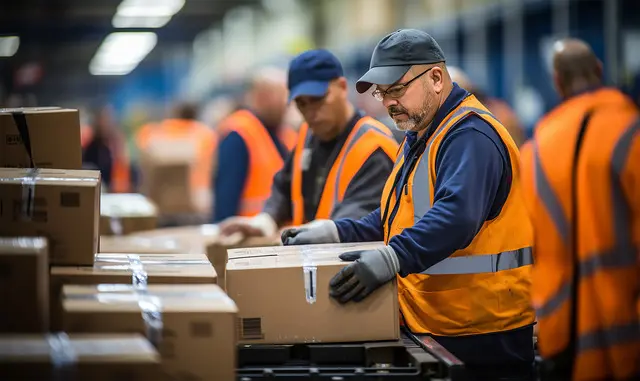Transforming Pick and Pack Operations with the Power of Automation
Introduction
In today’s fast-paced supply chain landscape, pick and pack automation has emerged as a game-changer for businesses seeking to streamline operations, improve efficiency, and enhance customer satisfaction. The traditional manual processes associated with pick and pack tasks can be time-consuming, error-prone, and labor-intensive, leading to inefficiencies and delays.
Pick and Pack Automation: A Path to Efficiency and Accuracy
Pick and pack automation leverages the power of Python, AI, and cloud-based solutions to automate various aspects of the pick and pack process, including:
- Receiving and processing picking lists or order fulfillment requests
- Locating items within the warehouse based on their storage locations
- Picking items from shelves or storage bins according to order specifications
- Packing items into appropriate containers or packaging materials
- Updating order status and notifying shipping teams for further processing
By automating these tasks, businesses can significantly reduce the time and effort required for pick and pack operations, while also minimizing errors and improving accuracy. This leads to increased productivity, reduced costs, and enhanced customer satisfaction.

Unleashing the Power of Python, AI, and Cloud for Pick and Pack Automation
Python, AI, and Cloud: A Trio for Enhanced Automation
Unattended Bots: Automating End-to-End Processes
Python’s versatility and ease of use make it an ideal language for developing unattended bots that can automate the entire pick and pack process, from receiving picking lists to notifying shipping teams. These bots can operate 24/7 without human intervention, ensuring uninterrupted productivity and efficiency.
Attended Bots: Empowering Human Workers
Attended bots, also built with Python, assist human workers in specific tasks, such as locating items within the warehouse or picking items from shelves. These bots provide real-time guidance and support, empowering workers to perform their tasks more quickly and accurately.
Cloud Platforms: Supercharging Automation Capabilities
Cloud platforms offer a comprehensive suite of features and capabilities that far surpass traditional RPA/workflow tools orchestrators. They provide:
- Scalability: Cloud platforms can easily scale up or down to meet changing business demands.
- Reliability: Cloud platforms offer high levels of reliability and uptime, ensuring uninterrupted automation operations.
- Integration: Cloud platforms seamlessly integrate with other enterprise systems, such as ERP and WMS, enabling end-to-end automation.
AI: Enhancing Accuracy and Handling Edge Cases
AI techniques, such as image recognition, natural language processing (NLP), and generative AI (Gen AI), can significantly enhance the accuracy and capabilities of pick and pack automation systems. For example:
- Image recognition: AI can identify and locate items within the warehouse based on visual cues, even in complex or cluttered environments.
- NLP: AI can interpret and process picking lists or order fulfillment requests, extracting key information and automating the picking process.
- Gen AI: AI can generate optimized picking routes and packing configurations, maximizing efficiency and minimizing errors.
By leveraging the power of Python, AI, and cloud platforms, businesses can create robust and scalable pick and pack automation systems that drive efficiency, accuracy, and customer satisfaction.

Building the Pick and Pack Automation with Python and Cloud
Step-by-Step Automation Development
The pick and pack automation process can be broken down into several sub-processes:
- Receiving picking lists or order fulfillment requests: Python scripts can be used to connect to the order processing system and retrieve picking lists or order fulfillment requests in real time.
- Locating items within the warehouse: Cloud-based inventory management systems can be integrated with Python scripts to locate items within the warehouse based on their storage locations.
- Picking items from shelves or storage bins: Python scripts can control robotic arms or other automated devices to pick items from shelves or storage bins according to order specifications.
- Packing items into appropriate containers or packaging materials: Python scripts can control automated packaging machines to pack items into appropriate containers or packaging materials.
- Updating order status and notifying shipping teams: Python scripts can update the order status in the order processing system and notify shipping teams for further processing.
Data Security and Compliance
Data security and compliance are paramount in the supply chain industry. Python scripts can be configured to use secure protocols and encryption methods to protect sensitive data. Additionally, cloud platforms offer robust security features and compliance certifications to ensure the security and integrity of automated processes.
Advantages of Python over No-Code RPA/Workflow Tools
Compared to no-code RPA/workflow tools, Python offers several advantages for building pick and pack automation systems:
- Flexibility: Python is a versatile language that allows for extensive customization and integration with other systems.
- Scalability: Python scripts can be easily scaled up or down to meet changing business demands.
- Cost-effectiveness: Python is an open-source language, which eliminates licensing costs associated with proprietary RPA/workflow tools.
Algorythum’s Approach
Algorythum takes a different approach to BPA by focusing on custom Python-based solutions rather than pre-built RPA tools. This approach is driven by client dissatisfaction with the performance of off-the-shelf automation platforms. Python provides greater flexibility, scalability, and cost-effectiveness, enabling Algorythum to deliver tailored automation solutions that meet the specific needs of each client.

The Future of Pick and Pack Automation
The future of pick and pack automation holds exciting possibilities for further enhancements and integration with other emerging technologies:
- Blockchain: Blockchain technology can be used to create a secure and transparent record of all transactions and activities within the pick and pack process, ensuring data integrity and traceability.
- IoT: IoT devices can be integrated with pick and pack automation systems to provide real-time visibility into inventory levels, equipment performance, and other operational metrics.
- AR/VR: AR/VR technologies can be used to create immersive training experiences for pick and pack operators, improving efficiency and safety.
Subscribe to Algorythum
Stay up-to-date on the latest trends and advancements in pick and pack automation by subscribing to our newsletter.
Contact Us
To get a free feasibility and cost-estimate for your custom pick and pack automation requirements, contact the Algorythum team today.

Algorythum – Your Partner in Automations and Beyond
At Algorythum, we specialize in crafting custom RPA solutions with Python, specifically tailored to your industry. We break free from the limitations of off-the-shelf tools, offering:
- A team of Automation & DevSecOps Experts: Deeply experienced in building scalable and efficient automation solutions for various businesses in all industries.
- Reduced Automation Maintenance Costs: Our code is clear, maintainable, and minimizes future upkeep expenses (up to 90% reduction compared to platforms).
- Future-Proof Solutions: You own the code, ensuring flexibility and adaptability as your processes and regulations evolve.









